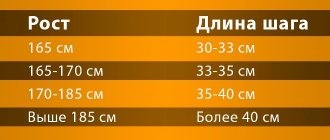The online calculator will calculate the length of your step and calculate the number of steps in 1 kilometer walked. It will be useful for those who strictly monitor their physical activity and use a pedometer while walking or jogging. To find out how far you have walked or run, calculate your stride length by entering your gender and height into the table.
Walking is the most beneficial sport that we all do every day. Even if the work does not involve physical labor, you still have to walk. Nutritionists and fitness trainers unanimously claim that simple walking helps to tidy up your figure and significantly lose weight, especially if you adhere to proper nutrition. In addition, regular walking helps strengthen the heart muscle and blood vessels, improves lung function and trains endurance.
No time for the gym - we walk to work
It is not at all necessary to have special electronic devices that will count the distance traveled. It is enough to know how many steps there are in 1 kilometer to understand how much time you need to spend walking. Without expecting it, we spend a lot of calories on this simple process. And the more you move, the more you spend. In addition, we must not forget that this promotes the active breakdown of fats. Therefore, knowing how many steps are in 1 kilometer, you can build an individual system for losing weight and improving your body’s health. This is a very good incentive to start walking home after work. And in a month you can lose several kilograms completely unnoticed.
Walking can be different too
The length of steps will vary from person to person. This depends primarily on the person’s height. The higher it is, the longer the step, and therefore the faster it will cover a certain distance. However, there is more to it than that. The size of the foot, as well as the shoes a person wears, also matters. For example, if you are walking in sports sneakers, then your stride length can be maximum, and even without speeding up, you will cover the distance a little faster. But a girl wearing high-heeled shoes will have a much shorter step length, and this in no way depends on the person’s height. When calculating how many steps are in 1 kilometer, we must not forget about such nuances.
What is the average step length when walking and running?
The usual walking pace, which rarely seems fast to anyone, is about 70-90 steps per minute (35-45 per leg). For such a gait, the average step length can vary from 65 to 85 cm. Once upon a time in Rus' there was even a “step” length measure, which, translated into modern unit systems, meant 71.12 cm.
In Ancient Rome they used the Passus measurement - a double step (the distance between the footprints of one foot) equal to 148 cm.
What about race walking, where professionals move at a pace that not every amateur runner can achieve?
Due to the fact that there is no flight phase in race walking, which, in fact, distinguishes it from running, the step length here is less than a running step, but the frequency reaches 200 per minute. The average length is 115-120 cm.
For running, this figure fluctuates around 100-180 cm, depending on running speed. Longer strides require more energy from the body.
Runners in good condition are able to achieve longer strides than their weaker competitors.
Additionally, stride length depends on hip mobility and flexibility. If you don't have full range of motion at your hip, you won't be able to take a longer stride. Glute strength also affects step length: it takes strong glutes to swing your leg back after taking a big step forward.
Not so simple arithmetic
As you can see, simply taking the final number will not work, and therefore you will have to make some calculations. True, you can use an approximate formula, which states that there are 1000 steps in 1 km. However, it is not at all accurate. It is taken as a basis that one step is about a meter, that is, in 1000 steps you will walk about 1 km. But the only option to obtain reliable data is to turn on any navigator and walk one kilometer, counting your steps.
Here are some approximate calculations by which you can find out how many steps there are in 1 km. For example, let's take a person who is 175 cm tall. He will need to take 1377 steps to cover the required distance.
We increase the load
If you want to take up walking in order to lose weight, then you definitely need to maintain a calorie deficit. In this case, you should know that just walking through the park, you will spend much less than if you are in a hurry. An athlete who uses a sports step will also work much more efficiently, with greater impact. When walking fast, the costs increase by about three times, which can be used for good. Walking up stairs, over rough terrain and uphill significantly increases calorie consumption. There's a slight catch here, though. Speaking about how many steps there are in 1 km, it should be noted that when going uphill, the step length decreases, which means that the initial calculations will no longer be correct. However, the effectiveness of such activities increases, and quality is much more important than quantity.
Alternative to fitness training
To have an excellent figure and excellent health, it is not at all necessary to attend any section. To do this, you don’t even need to know how many steps there are in 1 kilometer when walking. It is enough to simply refuse to travel to the store, to visit or to work on public or personal transport. Instead, walk everywhere. Of course, it will be necessary to reconsider the expenditure of personal time. However, a cheerful state and a toned figure will be an excellent reward for you. If you walk for 2 hours every day, and this is often your way to work and back, then in just a week you will burn more than 200 g of subcutaneous fat. If you do not indulge in fatty and sweet foods, and also do not overeat, then these reserves will not be renewed. Consequently, within a few months the result will be clearly visible on your silhouette.
Norm of steps per day
10,000 steps a day is a certain measure, but it cannot be called a universal indicator. As already noted, everything depends on the person, his state of health, and the age of the walker.
In childhood, a person can easily walk much more than 10,000 steps, and then gradually, moving from one age category to another, the mileage decreases, and in the presence of chronic diseases, a person’s activity decreases even more.
Thus, people of retirement age do not need to walk 10,000 steps a day to maintain health; 3,000-4,000 steps daily will be enough for them.
In young age
From an early age, if there are no serious health problems, you need to do physical exercise, walk, and be constantly in motion.
Among young people, there are many who lead an inactive lifestyle and eat mostly unhealthy fast food. All this has a negative effect on the body.
Every day young people should walk for at least a couple of hours. The number of required steps varies individually. Some can walk 5 km, while others can walk all 10 km. Walking speed also depends on the person. If you have a sedentary lifestyle, you should practice walking every day, gradually increasing the pace. Thus, you need to walk every day, gradually increasing the number of minutes and steps walked.
For women over 40
With age, the metabolic process slows down, and this is fraught with the appearance of extra pounds. One of the components of excess weight is a sedentary lifestyle. Without physical activity, the body loses tone and muscles weaken.
Walking is a wonderful sport, and an enjoyable one at that. But you don’t have to start walking for 3 hours straight right away. You need to gradually increase the duration of your walk. It's better to start with an hour's walk at a moderate pace. You need to walk not for a day or two, but constantly. If we talk about the number of specific steps that a woman over 40 needs to take, then this is directly dependent on her state of health.
How much should you walk a day?
We have already said: to be healthy, you must play sports. And the simplest and most accessible form of it is walking. We tried to calculate how many steps there are in 1 kilometer (as you know, there are 1000 meters, and there should be approximately the same number of steps). However, the question immediately arises about how many kilometers you need to walk a day in order not to have health problems. The 10,000 steps rule is quite popular. This norm came to us from Japanese everyday life. However, questions arise again. And if a person ate a hamburger or ice cream, should this norm be increased? Or can I leave it the same?
In fact, this figure came to us from ancient times, when the Japanese moved much more on foot, and their diet was much healthier. Therefore, this was only a guideline for a healthy lifestyle. Today, doctors are faced with the fact that for many people walking even 2000 steps a day becomes problematic. It is for these people that the desire to cover a little over eight kilometers every day is most significant. The bar should be raised gradually so that there is no temptation to quit this venture.
Walking rate per day in kilometers
Scientists have long proven that walking improves the functioning of the cardiovascular system, tones muscles, and tightens problem areas. To benefit from it, you need to walk 5 to 10 km a day. The more extra pounds a person has, the more he should move.
But you also need to walk correctly. It is unlikely that movement during which the “go re-athlete” chews a bun or talks on the phone will be beneficial. You should not eat anything an hour before walking
It is also important to monitor your own breathing and monitor your well-being. Discomfort when moving is a sign that a person is doing something wrong or is trying too hard.
How fast should you walk to lose weight?
Walking to improve health and walking to lose weight are two different concepts. In the first case, a person can move slowly, enjoying the beauty of the surrounding nature. At the same time, there may be a pedometer in his pocket, which will notify him that the minimum daily requirement has been passed and he can return home.
If you decide to walk a lot in order to lose weight, you will have to put in more effort. First you need to determine your own effective walking speed. The table will help with this:
| Speed (number of steps per minute) | Expected Result |
| 60 | Suitable for leisurely evening walks, does not provide weight loss. |
| 80 | Not enough for weight loss, optimal for improving the functioning of internal organs and systems. |
| 110 | Increasing metabolic rate, gradual destruction of fat depots. |
| 130 | Weight loss. |
| 140 or more | Strengthening muscles, burning fat deposits. |
You can determine your usual walking speed by using a stopwatch and counting how many steps you take per minute. Based on the results obtained, you can understand how much faster you need to move to start losing weight. All modern pedometers are also equipped with a function for determining the speed of movement.
How long should people of different ages walk?
The figure of 10,000 steps per day is an average figure that cannot be called universal. Thus, children aged 7 to 10 years can easily walk up to 11,000-15,000 steps, young people - up to 12,000, adults - from 5,000 to 10,000, elderly - from 3,000 to 5,000. In the presence of severe disease activity decreases even more.
In other words, retirees who suffer from leg or back pain do not necessarily have to exhaust themselves with 10,000 steps a day. It will be enough for them to do at least 3,000. At the same time, there is no need to limit the activity of children. They have a shorter stride length and can easily take many more steps than their parents.
How many steps are there in 1 km on average?
In order to know how many steps there are in one kilometer, you need to determine the person’s height. For example, if his height is 175 centimeters, then the average length of one step is 70 centimeters. Thus, there are about 1420 steps in one kilometer.
If a person is 160–165 centimeters tall, then his step is approximately 50 centimeters. With such indicators, there will be 2000 steps in one kilometer.
How many calories are burned?
When walking, as well as with other sports activities, there is a reduction in calories. On average, according to nutritionists, if a person walks slowly, but at the same time, without slowing down, exactly one kilometer, then it will take him 70 - 75 calories.
However, this value may be higher if the person:
- overcomes a distance with a load, for example, he has a heavy backpack over his shoulders or a bag in his hands;
- there are obstacles on the way, in particular, stones that need to be crossed, climbs, steep descents, etc.;
- dressed warmly;
- does in the summer:
- walks in uncomfortable shoes.
How many calories do 10,000 steps burn?
Many people strive to lose weight by walking. Since walking can be equated to long-term aerobic training that affects the breakdown of fat, this result is achievable (in combination with the right diet).
The pace of walking and the amount of excess weight are important (the more weight there is, the faster calories will be burned). Some pedometers have a calorie counting function, but you can do this calculation yourself using a specially developed formula. To do this, multiply the length of one step (in meters) by their number, then multiply by the person’s weight in kilograms, divide the resulting value by 2. The result will show the number of calories burned.
For example, a person weighing 80 kg with a stride length of 0.7 m walked at an average pace of 10,000 steps. Multiplying the last 2 numbers, we get the distance traveled - 7000 m. Multiply by weight 80 kg, and divide the result by 2. It turns out 280,000 cal or 280 kcal. This is the amount of energy a person burns after walking 10,000 steps. When walking fast, the same person can burn about 2 times more.
The effectiveness of losing weight through walking can be increased by using Nordic walking with poles. This style of physical activity has a number of advantages, since it loads not only the legs, but also the arms and shoulders. Involving the upper limbs in the walking process evenly loads most of the body's muscles.
Nordic walking is good not only for more efficient burning of calories, it improves cerebral circulation, relieves tension from all parts of the spine, strengthens the muscles of the shoulders, arms, back and ligaments in this area, increases coordination and concentration.
How to increase walking efficiency?
To lose weight, it is not enough to just walk occasionally. You need to walk regularly, and always try to increase the effectiveness of such physical activity.
Athletes, coaches and nutritionists recommend:
- Walk strictly according to a schedule, for example, choose 3-4 times a week, and in the morning.
- Walk exclusively in a good mood and when there is no general malaise or any diseases.
- Do not eat an hour before the start of your workout and limit your fluid intake.
- Wear only comfortable clothes, preferably a tracksuit, and sneakers (or sneakers).
- Take a small load with you, for example, put on a backpack in which you put 2 - 3 small books.
- Wrap thighs with cling film.
Also, to increase efficiency, nutritionists and athletes advise:
- eat only right and never overeat;
- three hours before bedtime, drink exclusively plain water;
- no alcohol or smoking;
- after walking, do simple exercises, for example, bending in different directions, shallow squats, or gentle swings of the legs.











